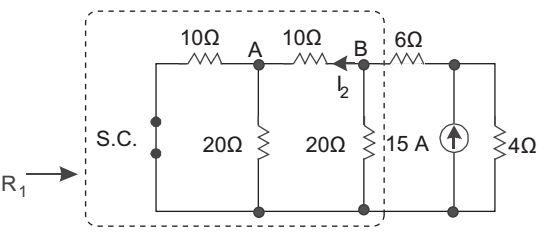Correct Option: C
The given circuit

Applying superposition theorem.
Case 1: When 60V source is taken, the equivalent circuit of the given circuit becomes.

Req = 10 + {20 || (10 + 20 || 10)}
| or Req = 10 + |  | 20 || | 50 |  |
| 3 |
| or Req = 10 + | 20 × | 50 |
| 3 |
|
| 20 + | 50 |
| 3 |
| Ieq = | V | = | 60 | = | 60 × 11 | = | 22 | A |
| VReq | 210/11 | 210 | 7 |
Let the current in the branch AB be I
1, then
| or I1 = | 22 | × | 3 × 20 | = | 12 | = | = 1.71 A (A to B) |
| 7 | 110 | 7 |
Case 2: When 15 A source is taken, the equivalent circuit of the given circuit becomes.

Let the current in the branch BA be I
2.

Where, R
1 = (10||20+10)||20
or R
1 = 100/7 Ω
| IR1 = 15 × | 4 | = | 15 × 4 |
| 4 + 6 + R1 | 4 + 6 + 100/7 |
| or IR1 = | 15 × 4 × 7 | = 2.47 A. |
| 170 |
and
| or I2 = | 2.47 × 20 × 3 | =1.34A (B→A)
|
110 |
Now, I = I
1 – I
2 = 1.71 – 1.34 = 0.37 A.








